Judi Lynn
Judi Lynn's JournalAs Venezuela Mends Ties With Latin Neighbors, Western Media Turn Up the Propaganda
JUNE 22, 2023
RICARDO VAZ
JUNE 22, 2023
Venezuela’s Maduro government has slowly and steadily regained its diplomatic standing in recent years, overcoming US endeavors to turn the country into a pariah state as part of its regime-change efforts.
Nevertheless, Washington remains hell-bent on ousting the democratically elected Venezuelan authorities, and has kept its deadly sanctions program virtually intact. And Western media, which have cheered coup attempts at every step of the way (FAIR.org, 6/13/22, 5/2/22, 6/4/21, 4/15/20, 1/22/20), remain committed to endorsing US policies to the bitter end.
. . .
The reporting around the latest developments saw corporate pundits showcasing a full array of journalistic con artistry to defend their “narrative,” including dubious sources, inaccurate conclusions and dishonest context.
Undemocratic references
Corporate media’s effort to dismiss Maduro’s legitimacy is heavily built around the use of negative labels. For example, “authoritarian” appears almost like an auto-fill suggestion at this point, given its prevalence (Financial Times, 6/4/23; BBC, 5/30/23; Reuters, 5/29/23; AP, 5/30/23; Washington Post, 5/30/23; Bloomberg, 5/31/23). Outlets like the Economist (6/1/23) and the Miami Herald (6/3/23) go straight to “dictator.”
. . .
Equally misguided were some attempts to justify the punishing coercive measures, with the BBC (5/30/23) stating that they were a response to a “crackdown on opposition activists,” and the Associated Press (5/30/23) reporting they were intended to “get Venezuela to liberalize its politics.” Even US officials have stated on the record that sanctions are meant to “accelerate the collapse” of the Maduro government (Voice of America, 10/15/18)—evoking President Richard Nixon’s command to “make the economy scream” in Salvador Allende’s Chile.
More:
https://fair.org/home/as-venezuela-mends-ties-with-latin-neighbors-western-media-turn-up-the-propaganda/
How Black people saved Rio de Janeiro's Tijuca forest
OPINION: Tijuca National Park is the largest urban rainforest in the world and the heart of Rio. Now, the little-known story of how six enslaved Black Brazilians helped save the land from complete deforestation in the 1860s is finally coming to light.
Kiratiana Freelon
|
Jun 20, 2023
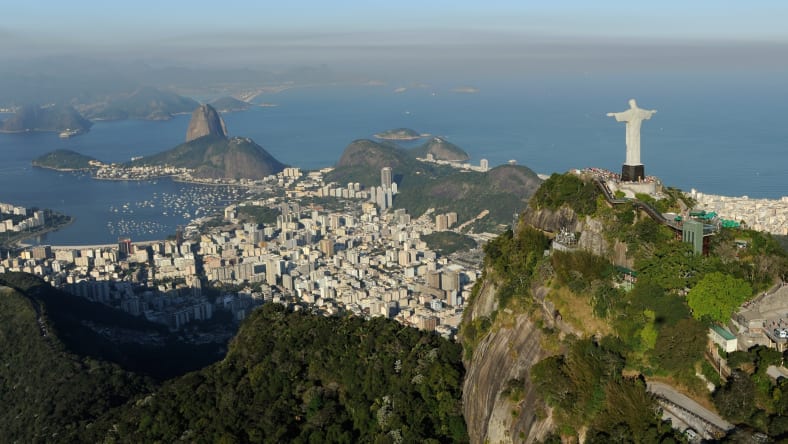
An arial view of the 'Christ the Redeemer' statue on top of Corcovado Mountain, situated in the Tijuca forest, on July 27, 2011 in Rio de Janeiro, Brazil. (Photo by Michael Regan/Getty Images)
Editor’s note: The following article is an op-ed, and the views expressed are the author’s own. Read more opinions on theGrio.
Aldison Almeida’s ancestry is strongly connected to the preservation of land.
Almeida is a leader of a Black community in Rio de Janeiro that borders a protected forest and state park. His work to protect his Camorim Quilombo community involves preserving and promoting Black Brazilian culture and periodically replanting the forest that has sustained and protected the community for hundreds of years.
He does this work in honor of his ancestors.
Twenty years ago, his father recounted a true story about Rio de Janeiro’s Tijuca National Park that few people know. In the 1860s, six enslaved Black Brazilians — Eleuterio, Constantino, Manuel, Mateus, Leopoldo, and Maria — saved the Tijuca forest from complete deforestation. Over 13 years, they planted more than 100,000 seedlings, preserving the forest.
When Almeida heard this story, he immediately felt an ancestral connection to these unheralded Black Brazilians.
“Everyone should know their names,” said Almeida. “But there is little written about them. There’s not even a placard with their names in the forest.”
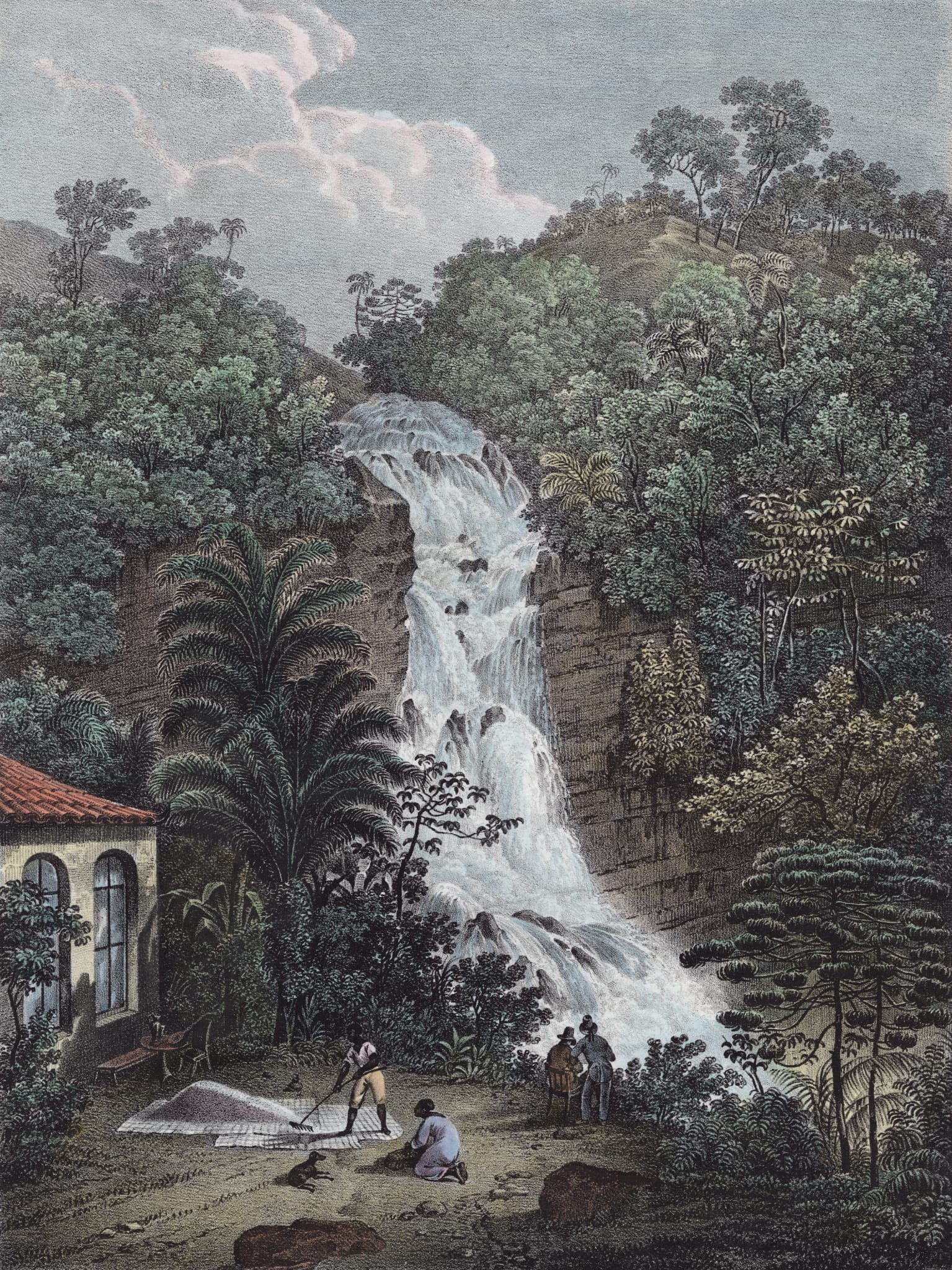
Tijuca forest, Rio de Janeiro Tijuca National Park, theGrio.com
A colored lithograph by Karl Joseph Brodtmann of the Tijuca forest waterfall in the Tijuca National Park, Rio de Janeiro, circa 1830s. Tourists are sketching the view while locals work nearby. (Photo by Hulton Archive/Getty Images)
Rio’s lush mountains would be barren without their work, and hundreds of thousands of people would have gone without drinking water in the late 19th century. The city now houses the largest urban forest in the world, creating a spectacular landscape. More than 246 kilometers of beaches wrap along an edge that spills into the Atlantic Ocean. The Sugarloaf Mountain juts out of the earth at one corner, creating one of its most recognizable landmarks. And in the middle of the city, the Christ the Redeemer statue of Jesus rises out of a 39.58 square kilometers tropical forest — the Tijuca forest. Within 20 minutes, one can go from a densely populated beach neighborhood to a thick, lush forest with multiple waterfalls.
Rio de Janeiro wouldn’t be Rio without Eleuterio, Constantino, Manuel, Mateus, Leopoldo and Maria.
More:
https://thegrio.com/2023/06/20/how-black-people-saved-rio-de-janeiros-tijuca-forest/
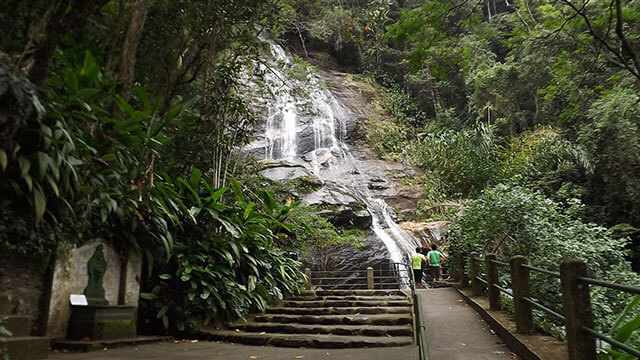




Many beautiful images of Tijuca Forest at google images, click this link:
https://tinyurl.com/4h7b3sbs
Indigenous Land With the Most Illegal Gold Mines in Brazil Has Bad Living Conditions (Portuguese)
JUNE 16, 2023
Indigenous Land With the Most Illegal Gold Mines in Brazil Has Bad Living Conditions (Portuguese)
Country:
Authors:
Vinicius Jorge Carneiro Sassine
AMAZON RJF GRANTEE
Lalo de Almeida
GRANTEE
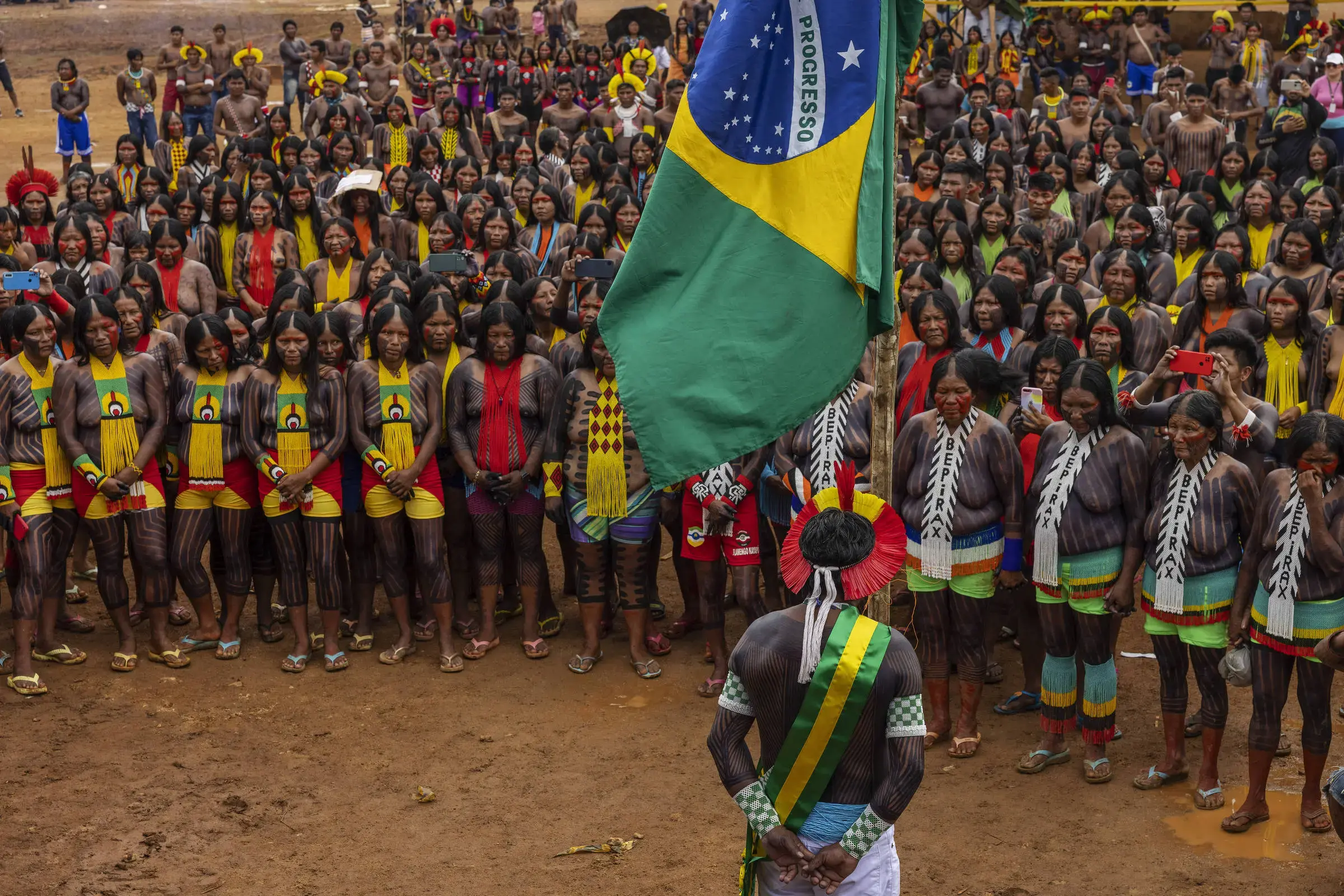
Image by Lalo de Almeida/Folhapress, Brazil, 2023.
This story excerpt was translated from Portuguese. To read the original story in full, visit Folha de S.Paulo.
Kayapó leaders seek ways to eliminate predatory activity, which prevents fishing and brings diseases to the communities.
João Kayapó, 53, is the new chief of the Turedjam village, a community surrounded by craters from illegal gold mining. The inauguration had a stage, red carpet, national anthem and the words of an indigenous pastor from the Assembly of God.
The party was grandiose. The village of 457 Kayapós Mebengôkres received more than 2,000 guests. They were indigenous people from 48 other villages, inside and outside the Kayapó TI (Indigenous Land), in the south of Pará.
Men and women painted themselves for the inauguration of the new cacique. Groups representing the invited villages sang and danced to welcome him—the men with a guttural voice, the women with a shrillness that approximates shouting, if it were not music. The cadenced steps and alternating groups filled the central courtyard of Turedjam.
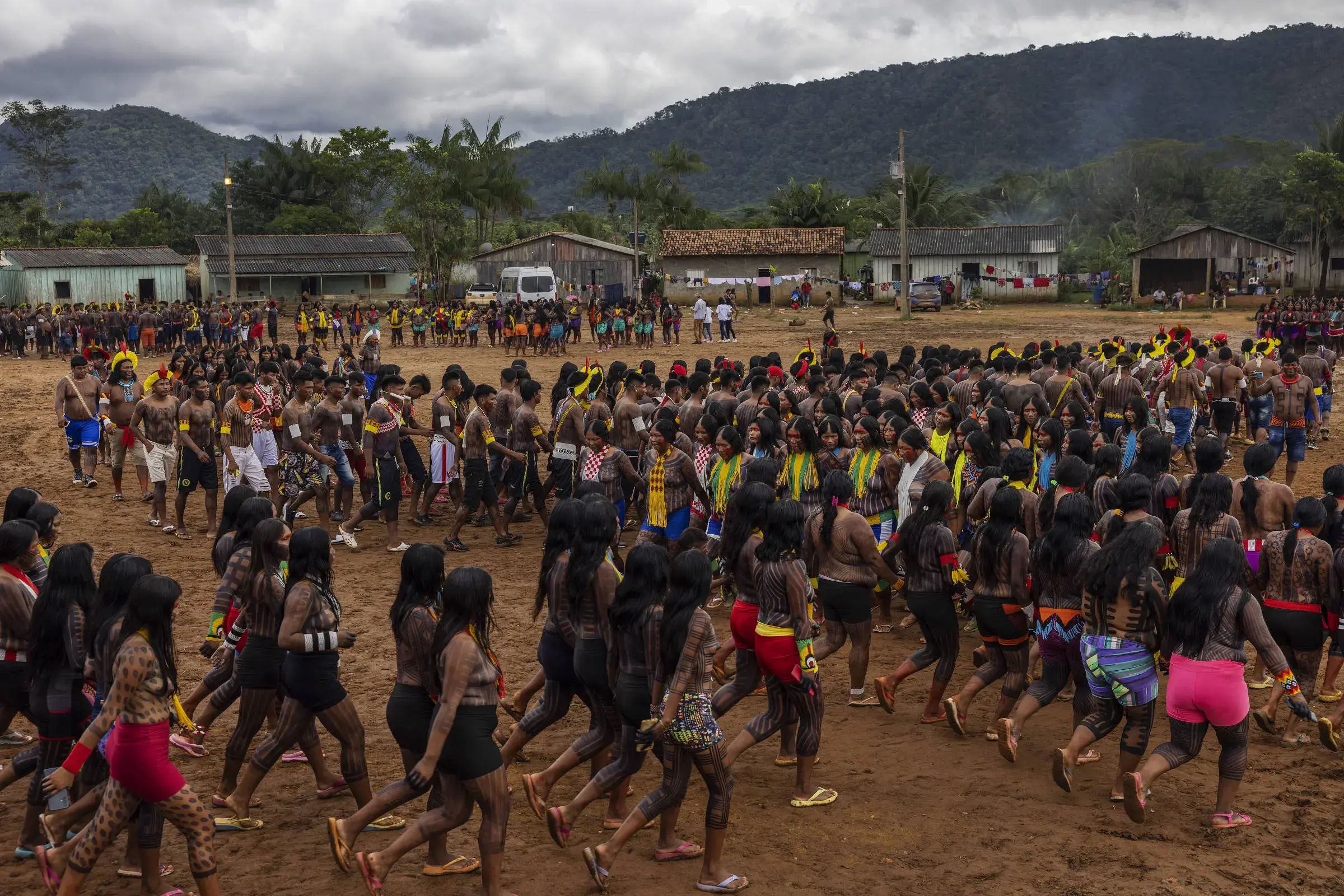
Image by Lalo de Almeida/Folhapress. Brazil, 2023.
More:
https://pulitzercenter.org/stories/indigenous-land-most-illegal-gold-mines-brazil-has-bad-living-conditions-portuguese
~ ~ ~
Izzatso, you snotty European-descended authors at Folha? The men have gutteral voices and the women's singing voices are shrill and sound like shouting??????
#### you! It might be appropriate if you attempted to realize you are really NOT superior to darker-skinned human beings from a different world experience.
The authors, as free-lance music critics would prefer the native Brazilian people sang like European opera stars.

Image of Vinicius Jorge Carneiro Sassine
AMAZON RJF GRANTEE
One of the co-authors of this Folha article.

Image of Lalo de Almeida
GRANTEE



'We are a force for life': how Indigenous wisdom helped rescue children lost in the Amazon
Nearly 100 members of Colombia’s Indigenous communities helped search for four children lost in the jungle for 40 days
Luke Taylor and Mat Youkee in Bogotá
Fri 16 Jun 2023 06.00 EDT
As they searched the trackless expanse of the Colombian Amazon for four lost Indigenous children, military rescue teams were well prepared for the seemingly hopeless task: high-resolution satellite technology helped them find the site where the light plane carrying the youngsters had crashed, and years of war with rebel groups meant the soldiers were used to operating in difficult terrain. But technology only gets you so far in the Amazon.
“We could see the leaves of the trees perfectly, but we did not know what was underneath them. That’s why everything that was found was by land. It was step by step – finding different pieces of evidence that were impossible for some to see,” Gen Pedro Sánchez, who oversaw the military operation, told reporters.
So to see the otherwise unseeable, President Gustavo Petro appealed to Colombia’s Indigenous communities to help find the children, aged between one and 13 years old, who were rescued a week ago after 40 days in the jungle.
Ninety-three people from Indigenous communities across the country – including members of the Siona, Nasa, Huitoto, Sikuani, Misak, Murui and Koreguaje peoples – were flown into the southern jungles to assist the 120 soldiers in searching for the children, said Luis Acosta, head of Colombia’s Indigenous guard.The volunteers’ efforts have since been praised by the military, who say their familiarity with forest conditions was vital in finding the children in time.
“It was the combination of our Indigenous knowledge with western knowhow, that’s how we got this result,” said Acosta, who coordinated the Indigenous response. “If it weren’t for our ancestral understanding of the forest – its medicinal properties, its life and its spirits – we would not have found the kids when we did.
More:
https://www.theguardian.com/world/2023/jun/16/indigenous-wisdom-colombia-amazon-children-rescue
Or:
(no registration)
https://archive.ph/WE7zS
El Salvador prosecutors said ex-president approved 1989 massacre of Jesuits
By MARCOS ALEMAN
June 6, 2023
SAN SALVADOR, El Salvador (AP) — Prosecutors in El Salvador say they have evidence that former President Alfredo Cristiani was present at a meeting that approved the 1989 massacre of six Jesuit priests and two others by soldiers.
Prosecutors who announced the case against Cristiani last year presented formal charges against the former president at an arraignment hearing late Monday, saying the plot to kill the Jesuits during the country’s 1980-1992 civil war went all the way to the top.
Cristiani, who left El Salvador in 2021 and whose whereabouts are unknown, has always denied knowledge of or involvement in the killings, which shocked the world. Prosecutors said that not only did Cristiani know about and approve the 1989 killings, he also held a phone call to reassure one of the priests before he was murdered.
. . .
A general amnesty passed in 1993 during Cristiani’s administration had prevented pursuit of those involved in war crimes until it was repealed in 2016.
. . .
On Nov. 16, 1989, an elite commando unit killed the six priests — five Spaniards and one Salvadoran — along with their housekeeper and the housekeeper’s daughter in the priests’ residence. The killers tried to make the massacre appear as though it had been carried out by leftist guerrillas.
More:
https://apnews.com/article/el-salvador-jesuits-massacre-civil-war-1989-69333406b5f259188d57d1734aa7a00a
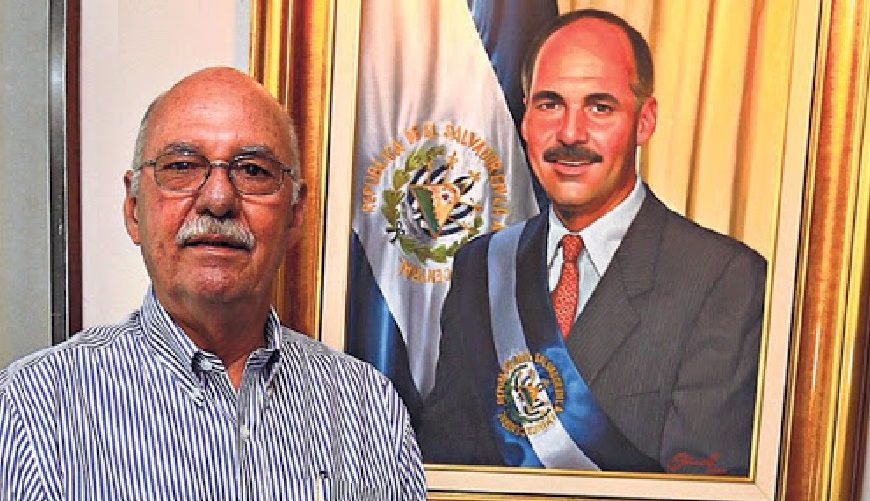

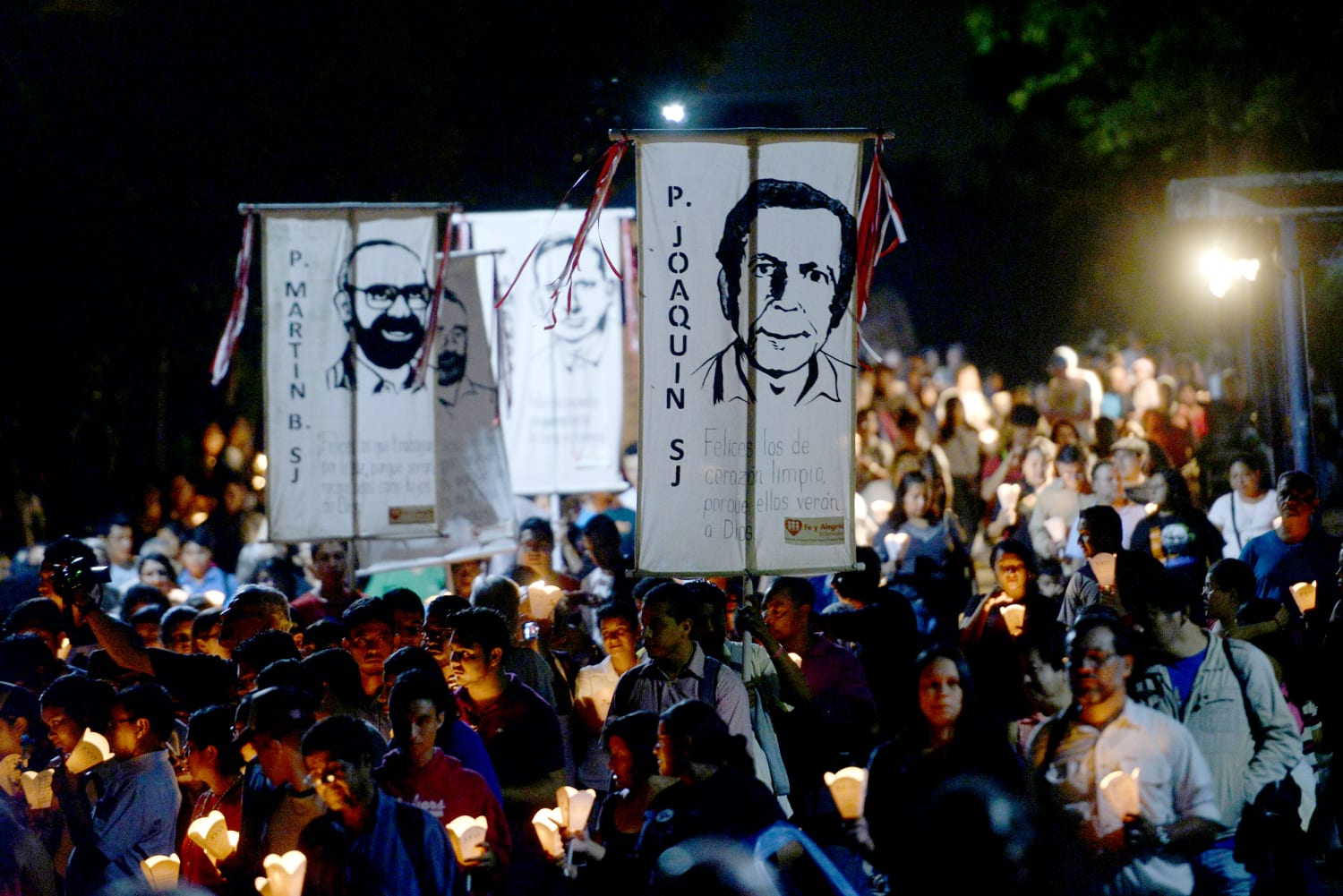
~ ~ ~
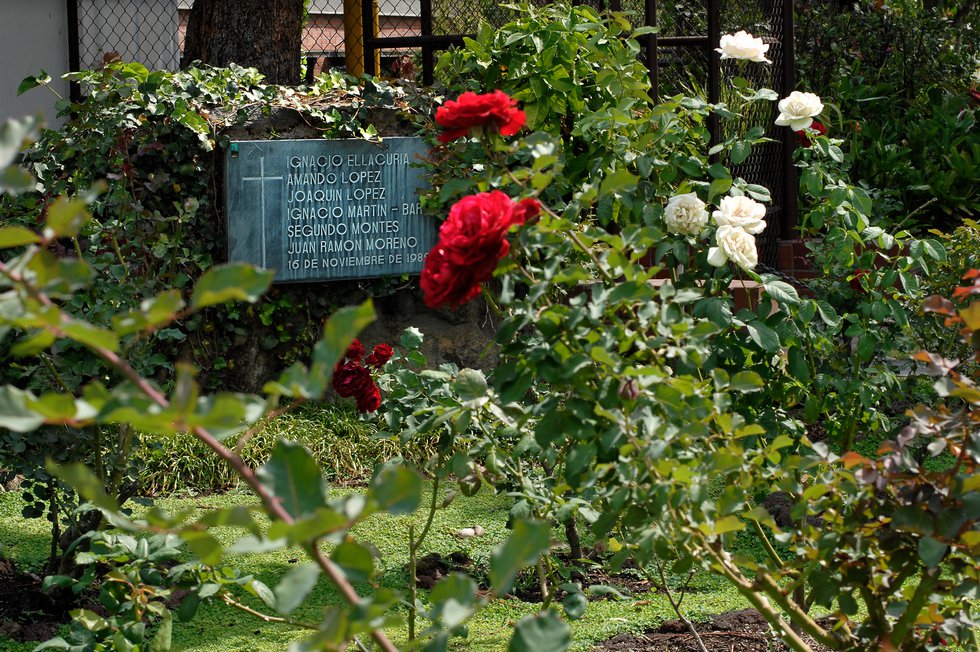
Screen Shot 2020-07-29 at 2.35.58 PM.pngJoeff DavisRose garden planted at the site of the 1989 murders. Photo by Joeff Davis
The Other Americans: Salvadoran Military Official on Trial for 1989 Killing of Jesuit Priests
The brutality was known by the Reagan and Bush administrations, but they lied to cover up the massacres for their own political gain.
BY JEFF ABBOTT JULY 30, 2020 8:00 AM
After more than three decades, human rights advocates in El Salvador and around the world, as well as the families of five Spanish Jesuit priests who were massacred by the Salvadoran military in November 1989, await the decision of a court in Madrid, Spain, against former Salvadoran Colonel Inocente Orlando Montano Morales, who is accused of planning the killings.
The trial, conducted on video due to COVID-19, began in June and came to an end on July 15. Colonel Montano served as vice minister of defense and public safety for the Salvadoran government during that country’s twelve-year civil war. He was one of seventeen people accused in Spain—the home country of five of the six murdered Jesuit priests—of planning the massacre. He was extradited from the United States in 2017. The trial in Madrid was held under the principle of universal jurisdiction, which permits human rights crimes committed in one country to be investigated and tried in another.
. . .
Early on the morning of November 16, 1989, soldiers from the infamous Atlacatl battalion, a counter-insurgency battalion trained by the United States, invaded the campus of the Jesuit-run university in San Salvador, El Salvador’s capital city. The soldiers were given orders to “leave no witnesses.”
. . .
During the massacre, soldiers also set fire to the rooms, burning images and paintings of Monseñor Romero, the Archbishop for San Salvador who was assassinated in 1980 after he had spoken out against the human rights violations carried out by the Salvadoran military. In October 2018, Monseñor Romero was declared a saint by the Catholic Church.
More:
https://progressive.org/latest/salvadoran-official-killing-jesuit-priests-abbott-200730/
HOW EXXON CAPTURED A COUNTRY WITHOUT FIRING A SHOT
Guyana is poised to become Exxon’s top global oil producer. Where the company ends and the government begins is increasingly unclear.
Amy Westervelt
June 18 2023, 6:00 a.m.
GUYANA’S HIGH COURT handed down a historic ruling in May against both the country’s Environmental Protection Agency and Exxon Mobil’s subsidiary in the region. If it sounds strange that the EPA and Exxon were co-defendants in a case, yes, that’s precisely the point.
The case was brought on behalf of two Guyanese citizens, Frederick Collins and Godfrey Whyte. They accused the EPA of failing to enforce the requirements of its own permits by never securing a guarantee from Exxon or its subsidiary, Esso Exploration and Production Guyana Limited, that the company would cover all costs related to a possible oil spill.
“Guyana taxpayers are currently exposed,” Tom Sanzillo, director of financial analysis for the Institute for Energy Economics and Financial Analysis, said. “The potential consequences for Guyana are catastrophic.”
That’s because Exxon’s drilling project in Guyana is the riskiest kind: deep-water offshore drilling, which involves intense pressure bearing down on complex equipment. The conditions are similar to those that preceded the Deepwater Horizon explosion in 2010, which spewed oil and gas throughout the Gulf of Mexico, costing BP $69 billion.
. . .
In Guyana, it’s become hard to distinguish where the oil company ends and the government begins. Exxon executives join the Guyanese president in his suite at cricket matches, and the vice president regularly hosts press conferences to defend the oil company. Vincent Adams, a Guyanese petroleum engineer and former head of the country’s EPA, has been one of the agency’s harshest critics.
More:
https://theintercept.com/2023/06/18/guyana-exxon-mobil-oil-drilling/
Repentant ranchers rescuing Colombian wildlife

Samantha Zapata, animal caretaker, feeds parrots with her parents Dora Sanchez and Hector Zapata at La Nupana natural reserve, as part of its rehabilitation process in Agua Bonita, San Jose del Guaviare, Colombia, on June 2, 2023. - AFP photos
1 hour ago
Two newborn pumas and a convalescing porcupine share a room in the home of the Zapata family, which has renounced livestock farming to focus on stewardship of the Colombian Amazon and its animals uprooted by deforestation. Just over a decade ago, the Zapatas decided to change their ways, and instead of cutting back trees for pasture, plant new ones. They sold their cows and let the jungle claim back most of their land in San Jose de Guaviare in southern Colombia. Today, the family of three work to rehabilitate animals affected in a variety of cruel ways by humanity’s encroachment on nature.
They sacrificed part of their home and backyard, where for the moment they house 60 creatures, ranging from monkeys, birds and armadillos to a spotted wild cat known as an ocelot. “This farm was dedicated to cattle raising: 56 hectares of which only about 12 (hectares) were… forest,” said Dora Sanchez, who runs the ranch-turned-reserve with husband Hector Zapata, 57, and daughter Samantha, 23. “Little by little, my family understood that (conservation) is a good thing,” the 48-year-old told AFP on the former ranch now called the Nupana reserve.

A crab-eating fox (Cerdocyon thous)
and brown capuchin (Sapajus apella)
play at La Nupana natural reserve.

Two woolly monkey (Lagothrix lagotricha)
cubs are seen at the reserve.

A wounded crested porcupine (Hystrix
cristata) is seen at the reserve.
“We must preserve and protect the forest, because it is the source of life… We are one hundred percent convinced that it is the jungle” that is the future, she added. ‘Positive effect’ Like many others in this rural department of Guaviare, the Zapatas were attracted by the dream of making a new life in a “land without men for men without land.” When Sanchez and Zapata moved there in 1997, most of the locals were raising cattle or planting coca – the raw ingredient of cocaine, of which Colombia is the world’s main producer. Both cattle and cocaine are jungle killers and Guaviare lost some 25,000 hectares of forest just in 2021, according to authorities.
The family raised cattle for 15 years before deciding this was no longer for them. By 2012, the last cows left the farm. “I began to do some experiments, to set up agroforestry systems and we began to see the positive effect,” said Sanchez, an agroforestry engineer by training. “The forest began to change, the fauna began to return. We improved the water conditions and the soil began to improve.” Today, the reserve has 40 hectares of jungle, said Sanchez, and tourists visit its eco trail. Some “adopt” an animal and make monthly contributions for its upkeep. Baby animals are cared for in the family house. Roaming free on the property, a small grey fox and a capuchin monkey that lost a leg chase each other around playfully – among the animals too domesticated or weak to return to the wild.

Samantha Zapata carries two armadillo cubs.

Dora Sanchez touches an ocelot at the reserve.

An owl is seen at La Nupana natural reserve.
More:
https://www.kuwaittimes.com/repentant-ranchers-rescuing-colombian-wildlife/
'Fruits, seeds and water' were pivotal in keeping four children alive in the Amazon rainforest
By Caitlin Hu, Tara John and Stefano Pozzebon, CNN
Updated 8:25 AM EDT, Sun June 18, 2023
When four young indigenous children were found last week after 40 days in the Colombian Amazon jungle, their rescuers noticed that the oldest, 13-year-old Lesly Jacobombaire Mucutuy, had something hidden between her teeth.
“We found she had a couple of seeds slowly chewed between her cheeks and her jawbone,” said Eliecer Muñoz, one of the four indigenous guards who made the very first contact with the children.
Muñoz told CNN the seeds were from a native Amazon palm tree called Oenocarpus Bataua, colloquially known as “milpesos” in Colombia.
Its fruits are rich in fat and Amazon tribes use them to make a vegetable oil, but Leslie’s seeds were still unripe when she was found, Muñoz said.
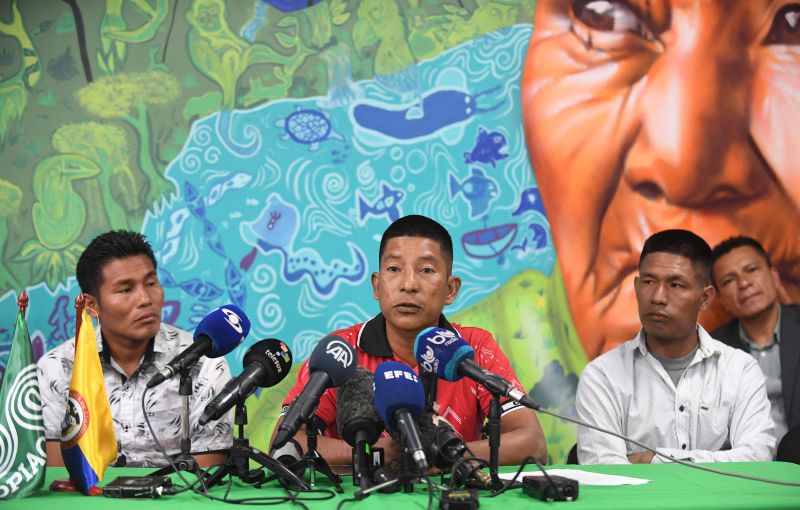
Eliecer Munoz (C), who was one of the indigenous guards who found the four children, talks during a press conference in Bogota, on June 15, 2023.
Daniel Munoz/AFP/Getty Images
“She was keeping them so that the warmth of her mouth would open up the seeds and she could feed the pulp to her younger siblings,” Muñoz says. “That’s how they stayed alive.”
More:
https://edition.cnn.com/2023/06/18/americas/colombia-amazon-rainforest-rescue-indigenous-children-intl/index.html
Peruvian paramilitary chiefs convicted of a murder in the 1990s
Saturday, June 17th 2023 - 09:44 UTC

Montesinos was then-President Fujimori's Chief Intelligence Officer
Former Peruvian National Intelligence Service (SIE) Chief Vladimiro Montesinos and Santiago Martin Rivas, leader of the paramilitary Colina Group created under then-President Alberto Fujimori, were sentenced Friday to 23 years in prison for the premeditated murder of Mariella Barreto, it was reported in Lima.
Warrant Officer Mariela Barreto Riofano was an Army Intelligence operative who revealed the crimes of the Colina Group, as well as Montesinos' plans to kill journalists who opposed Fujimori's government (1990-2000). When her torso was found in a bag in northeastern Lima on March 23, 1997, she was 28 years old and the mother of two girls.
It was during Fujimori's second five-year term. Terrorists of the Tupac Amaru Revolutionary Movement (MRTA) had taken diplomats, high authorities, and even some of Fujimori's relatives hostage at the residence of the Japanese ambassador in Lima. They had promised to release them only in exchange for the release of more than 400 of their comrades in prison.
While keeping the appearance that he was willing to negotiate, Fujimori ordered the construction of a tunnel under the residence to eventually send in troops in what was known as the Chavín de Huántar operation.
More:
https://en.mercopress.com/2023/06/17/peruvian-paramilitary-chiefs-convicted-of-a-murder-in-the-1990s
This Mayan Ruin South Of Cancun Will Open To The Public For The First Time Ever
Last updated: June 17, 2023
Mayan ruins are a big part of the reason why Mexico is so popular as a tourist destination, particularly among History enthusiasts.
Belonging to the wider Mayan World, it is home to over 200 archaeological zones, where some of the most impressive structures of the ancient civilization, including the world-famous step pyramids and the ball courts, can still be seen.

While open-air museums like Chichen Itza and the Tulum ruins are well-known to the wider public, one of Mexico’s priceless Mayan treasures had remained sealed off for decades as excavations and conservation efforts were underway, though that is changing soon.
A Mayan ruin with restricted access is opening for visitors for the first time, and if you’re planning a trip to Cancun for 2024, you could be among the first to explore it:
The Legendary Ichkabal Is Opening To The Public For The First Time In History

![]()
More:
https://www.traveloffpath.com/this-mayan-ruin-south-of-cancun-will-open-to-the-public-for-the-first-time-ever/
Profile Information
Member since: 2002Number of posts: 160,524